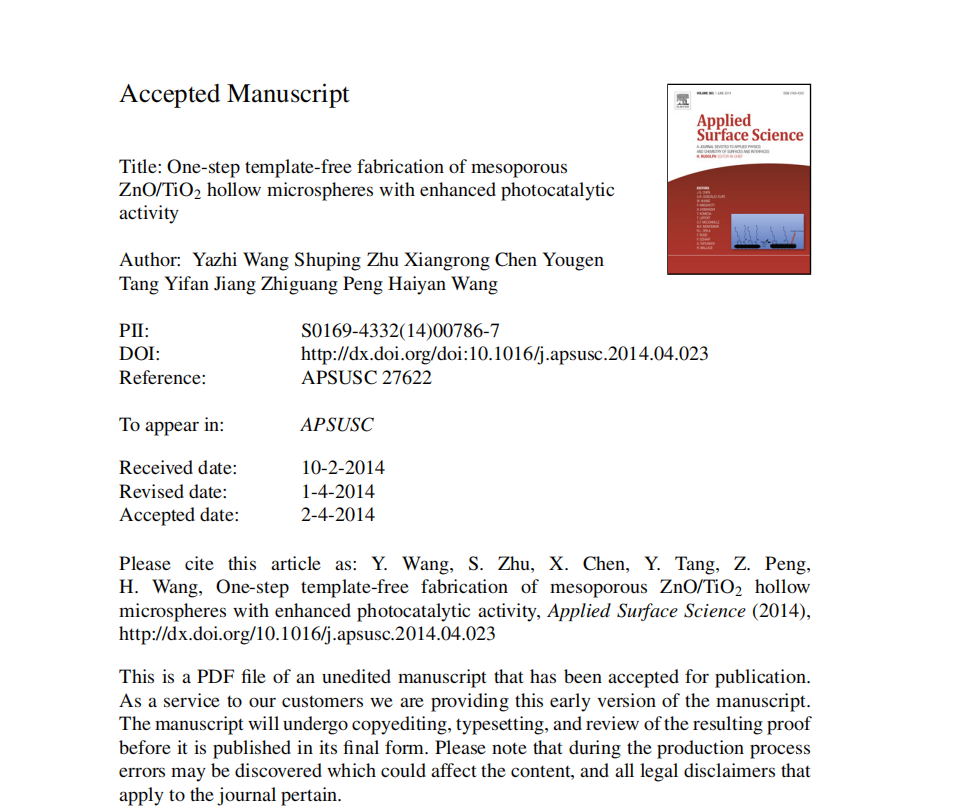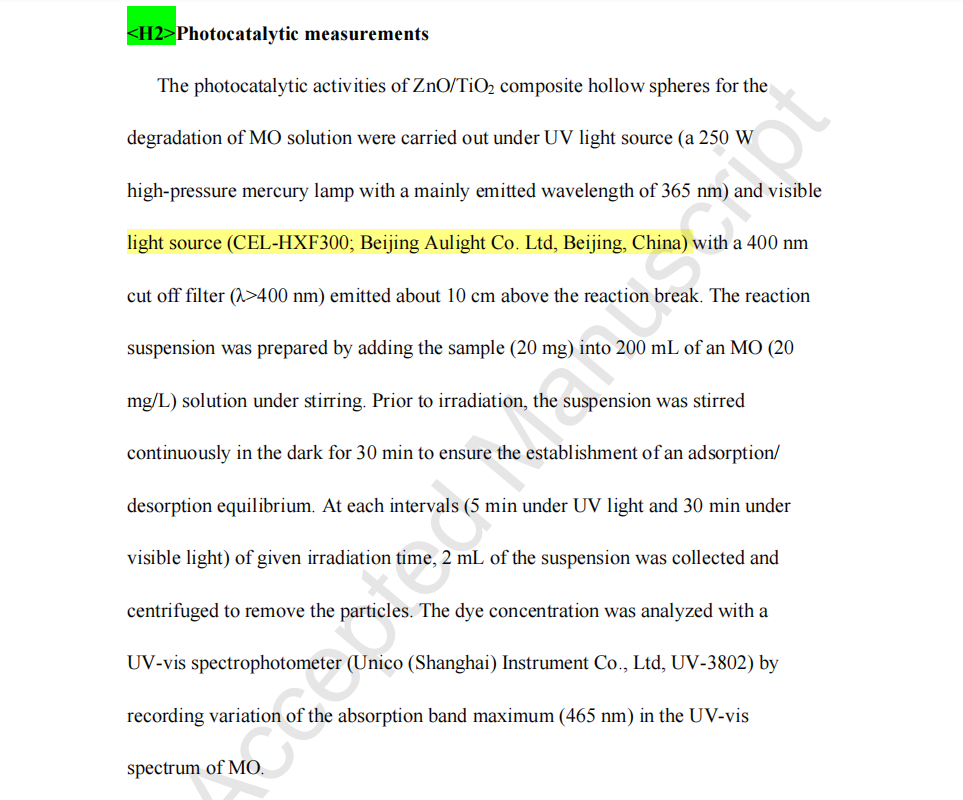Service hotline
+86 18518316054
 Current location : Home page > Resources > Papers > One-step template-free fabrication of mesoporous ZnO/TiO2 hollow microspheres with enhanced photocatalytic activity
Current location : Home page > Resources > Papers > One-step template-free fabrication of mesoporous ZnO/TiO2 hollow microspheres with enhanced photocatalytic activity
Author: Yazhi Wang Shuping Zhu Xiangrong Chen Yougen Tang Yifan Jiang Zhiguang Peng Haiyan Wang
Abstract
Mesoporous ZnO/TiO2 hollow microspheres have been successfully synthesized by a facile one-step hydrothermal route without any template. The effect of reactants, temperature and hydrothermal time on the morphology and photocatalytic degradation activity has been investigated in details. The hollow microspheres with average diameter of 0.5~2 μm showed time-dependent growth process and consisted of nanoparticles with a diameter of 10-20 nm. The photocatalytic activity of ZnO/TiO2 hollow microspheres was evaluated via the photocatalytic degradation of methyl orange (MO). Compared with the pristine TiO2 hollow microspheres or ZnO nanosheets, the ZnO/TiO2 hollow microspheres produced significantly positive effect on the band-gap energy shift (from 3.16 eV (TiO2) to 2.80 eV (ZnO/TiO2)) and photocatalytic degradation (with a high apparent reaction rate of 10.19×10-2 min-1) probably owing to the hybrid hollow microsphere morphology and their synergistic catalytic effect.
Introduction
Among various semiconductor oxides, TiO2 has been considered as one of great important materials because of their high photocatalytic activity, absence of toxicity, chemical stability and relatively low cost [1-4]. Since Fujishima and Honda [5] found a TiO2 photocatalytic anode could split water into hydrogen and oxygen as a clean source under ultraviolet illumination, it has received extensive attention for its destruction of pollutants [6, 7] and production of hydrogen [8-10]. The photocatalytic ability of TiO2 can be significantly improved by modifications on its surface and coupling with other sulfides or oxides [11-15]. Besides the wide application as electronic devices, ZnO is also an important photocatalytic material with a versatile wide band gap (3.37 eV) [16] compared with pristine TiO2 (3.2 eV), and the photodegradation mechanisms of ZnO and TiO2 have been proven to be similar [2]. The ZnO/TiO2 composite not only achieves efficient electron/hole pairs under illumination and higher reaction rates than other semiconductor couples, but also introduces impurity and defect levels to the forbidden band of TiO2 [15, 17-19], which may decrease the band gap of TiO2 and reduce the excitation energy of the composite. On the other hand, the coupling can prolong the duration period of the separation of electrons and holes, thereby reducing their recombination chance.
Spherical hollow structures are receiving a great deal of attention because of the lowest surface/volume ratio for aggregated products. With this regard, nanometer or micrometer scale TiO2 [20, 21] and ZnO [22, 23] hollow spheres have been well studied, which is beneficial to photocatalytic properties probably due to the large specific surface area, low density and highly efficient light-harvesting abilities. Kunio et al. concluded that the high photoreactivity of TiO2 hollow spheres could be attributed to the multiple diffraction and reflection of the irradiation on the surface of the materials [24].
Experimental
Photocatalytic measurements
The photocatalytic activities of ZnO/TiO2 composite hollow spheres for the degradation of MO solution were carried out under UV light source (a 250 W high-pressure mercury lamp with a mainly emitted wavelength of 365 nm) and visible light source (CEL-HXF300; Beijing Aulight Co. Ltd, Beijing, China) with a 400 nm cut off filter (λ>400 nm) emitted about 10 cm above the reaction break. The reaction suspension was prepared by adding the sample (20 mg) into 200 mL of an MO (20 mg/L) solution under stirring. Prior to irradiation, the suspension was stirred continuously in the dark for 30 min to ensure the establishment of an adsorption/ desorption equilibrium. At each intervals (5 min under UV light and 30 min under visible light) of given irradiation time, 2 mL of the suspension was collected and centrifuged to remove the particles. The dye concentration was analyzed with a UV-vis spectrophotometer (Unico (Shanghai) Instrument Co., Ltd, UV-3802) by recording variation of the absorption band maximum (465 nm) in the UV-vis spectrum of MO.


Results and discussion
Fig. 1 shows the XRD patterns of as-synthesized TiO2, ZnO and ZnO/TiO2 composite. As can be seen, the sole TiO2 can be well indexed to anatase structure (JCPDS No.65-5714) without any impurity diffraction peaks. Good crystallization is also demonstrated from sharp diffraction peaks. Meanwhile, the XRD pattern of ZnO is in good agreement with wurtzite hexagonal phase (JCPDS No.36-1451). As for ZnO/TiO2 composite, it is interesting to note that the diffraction peaks of both anatase TiO2 and wurtzite ZnO could be observed in the as-prepared composites, implying that the composites consist of TiO2 and ZnO. And there is no other impurity phase from the XRD diffraction peaks. This is similar to the reported results [11, 33]. The average crystalline sizes of above three samples calculated using the diffraction peaks (101) of anatase phase for TiO2 or wurzite phase for ZnO from Scherer’s formula [34] are in the range of 10-20 nm which is consistent with the TEM result in Fig. 2c.
The SEM image in Fig. 2a shows the overview of the uniform spherical morphology of ZnO/TiO2, and it can be clearly observed that the ZnO/TiO2 microspheres have a diameter of 0.5~2 μm. The hollow and nanoparticles aggregated structure can be judged by a cracked ZnO/TiO2 microsphere in high magnification image in Fig. 2b. TEM image in Fig. 2c can also indicate that the shell of the products is made up of the aggregated nanoparticles with a diameter of 10-20 nm (can also be seen in inner image of Fig. 2c). The corresponding SAED pattern (Fig. 2d) reveals the polycrystalline nature of the as-prepared microspheres and the diffraction rings from inside to outside can be indexed to anatase (101), wurtzite (100), wurtzite (102), anatase (105) and wurtzite (103). The HRTEM (Fig. 2e) from the edge of the observed ZnO/TiO2 hollow sphere displays three types of clear lattice fringes, which are embedded in amorphous matrix. Two sets of the fringes spacing are 0.25 nm and 0.28 nm, corresponding to the (101) and (100) planes of wurtzite ZnO. Another set of the fringes spacing (0.35 nm), corresponds to the (101) lattice spacing of the anatase TiO2. EDS analysis result can give the chemical composition of the ZnO/TiO2 hollow sphere catalyst on the surface. As shown in Fig. 2f, the peaks of O, Zn and Ti can be clearly seen while no other elements are detected besides Au (arising from the conductive gold coating prior to imaging) and C (originating from the underlying conductive carbon tapes), further supporting the existence of ZnO/TiO2 composite.
The optical band gaps of as-prepared TiO2 and ZnO/TiO2 hollow spheres were studied by means of UV-vis optical absorbance spectra (Fig. 3). The absorption onsets are determined by linear extrapolation from the inflection point of the curve to the baseline. From the absorption spectra between 230 and 800 nm, the absorption onsets of pure TiO2 and ZnO/TiO2 hollow spheres are around 392 nm and 442 nm, corresponding to band gap energy of 3.16 eV and 2.80 eV. The reduction in band gap energy of ZnO/TiO2 composite can be due to the synergistic effect between the conduction band of ZnO and TiO2 [35].Conclusion
In summary, mesoporous ZnO/TiO2 hollow spheres with an average diameter of 0.5-2 μm were prepared via a facile one-step template-free method, which is based on the similarities in chemical properties between TiO2 and ZnO. In comparison with TiO2, the band gap energy of ZnO/TiO2 hollow spheres was decreased from 3.16 eV to 2.80 eV because of the coupling of ZnO. Based on various morphologies and the K of photodegradation observed in different conditions, we found that the addition of fluorine and ammoniate, hydrothermal temperature and hydrothermal time are essential to the structure and photocatalytic activity. Mesoporous ZnO/TiO2 hollow microspheres exhibited much better photocatalytic degradation activity of MO in comparison to bare ZnO nanosheets and TiO2 hollow spheres, because the coupling of two sole simiconductor and red shift from near UV to the visible region could significantly enhance the separation and transport of photogenerated electron-hole pairs. A plausible time-dependant formation mechanism of ZnO/TiO2 hollow spheres was proposed based on the detailed morphologies variations of as-prepared products in different conditions.